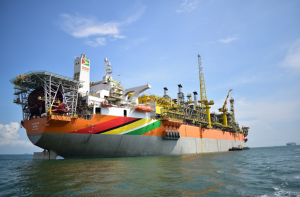–authorities assessing implications of production woes to protect national interest
REDUCED production levels at ExxonMobil’s Liza Phase One operation have not affected Guyana’s oil lift, as it was safely and successfully completed on Wednesday, at planned quantity, and in keeping with the Crude Lifting Agreement and lifting schedule.
Lifts are done every eight to nine days, and, with production levels low, there were concerns that the operator would not meet the quota of just about one million barrels within the expected time. It was reported recently that ExxonMobil, while conducting final checks on the recently re-installed flash-gas compressor on the Liza Destiny Floating Production Storage and Offloading (FPSO) vessel offshore Guyana, encountered another issue, which forced them to slash their production temporarily, by at least 75 per cent.

According to ExxonMobil, its regular daily production of about 120,000 barrels has been reduced to 30,000 per day, a decrease of 90,000 barrels.
“We have reduced production to a minimum level that mitigates formation of hydrates in subsea systems, maintains gas injection and fuel gas to the power generators, and minimises flare,” ExxonMobil’s Public and Government Affairs Adviser, Janelle Persaud said in an official update on Tuesday.
According to Persaud, production was reduced significantly because the company encountered problems related to the discharge silencer, which is a component of the recently re-installed flash-gas compressor. The compressor was damaged in January, and resulted in the company having to temporarily increase gas-flaring to above pilot levels in order to maintain safe operations. The faulty contraption was subsequently removed and sent to Germany for immediate repairs. The repaired and upgraded components of the flash-gas compression system have been safely re-installed, but a comprehensive three-phase testing programme was undertaken to ensure full safety.
It was during the final stage of the three-phase testing programme that the company encountered a problem with the discharge silencer. A discharge silencer is used to attenuate noise produced by the expansion of air, steam or gas at elevated pressure to atmospheric pressure. In a statement issued on Wednesday evening, the Ministry of Natural Resources said that the Government of Guyana (GoG) was notified of an unexpected issue arising with the discharge silencer of the flash-gas compressor. As part of efforts to rectify the issue, a team from SBM Offshore, MAN Energy Solutions and ExxonMobil are on site, assessing repairs, with support from engineering experts in Europe and the USA.
At this time, the compressor remains offline, and production and flaring volumes are being closely monitored, the Ministry of Natural Resources (MNR) said.
The government, through MNR, the Guyana Geology and Mines Commission (GGMC), and the Environmental Protection Agency (EPA), has been receiving regular updates on the matter. And, officials of the MNR met with representatives of the company on Wednesday to discuss its findings, and plans for the expeditious resolution of this issue.
“The GoG is, as would be expected, highly disappointed with the operator’s inability to resolve this situation to date, and will continue to monitor the levels of daily crude oil output and flaring to best allow for an economically-feasible level of production during this period. “The GoG is currently examining the implications of the loss of output, and consequently loss of income and revenue, including measures that it may have to institute to protect national interest,” the Ministry of Natural Resources said.
ExxonMobil Guyana has since said that it is extremely disappointed by the design issues and continued underperformance of the compressor, and will be working with the equipment manufacturer, MAN Energy Solutions, and the vessel’s operator, SBM, to rectify the situation. This performance is below ExxonMobil’s global expectations for reliability, the company said.
It was in early March that Guyana benefitted directly from its petroleum sector, receiving US$61,090,968 (approximately G$13B) from the sale of the nation’s fifth oil lift. The fifth lift was sold to New York-based Hess Corp, which, in turn, vended the local crude to HPCL-Mittal Energy Ltd (HMEL), a joint venture between State-run Hindustan Petroleum Corp. and Indian steel tycoon, LN Mittal.
HMEL reportedly operates a 226,000 barrels per day ‘Bathinda’ refinery in the northern state of Punjab.
Prior sales of local crude, particularly the first three, went to a trading arm of Shell on a dated ‘Brent’ basis.
Guyana, new to the petroleum sector, sold its first one million barrels of crude on February 19, 2020, raking in nearly US$55 million. In its second million-barrel sale, the country received US$35 million, and US$46 million as proceeds from the sale of its third million-barrel of crude, and US$49.3 million from its fourth oil lift.
Based on a consolidation of all the lifts to date, the country has sold 5,009,797 barrels of oil valuing US$246,542,662.
Along with the earnings from the oil lifts, and over US$21 million in royalties and interest, Guyana has close to US$267,668,709 in its Natural Resources Fund (NRF) at the U.S. Federal Reserve Bank. Under the Production Sharing Agreement (PSA), Guyana receives a two per cent royalty, and a 50 per cent profit oil, which is what remains after the producer recovers the production cost.



.jpg)










